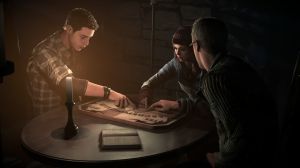Until Dawn Review: Trope Scares
 One of the alleged selling points of The Order: 1886 was that it was “cinematic” but it didn’t really feel like anything out of a movie other than the aspect ratio of the screen. To make a game that seems like a movie, you need to rely on more than just the visuals. Ready at Dawn missed that memo.
One of the alleged selling points of The Order: 1886 was that it was “cinematic” but it didn’t really feel like anything out of a movie other than the aspect ratio of the screen. To make a game that seems like a movie, you need to rely on more than just the visuals. Ready at Dawn missed that memo.
Supermassive Games didn’t miss that memo. They had last year’s PS4 exclusive that was noteworthy for all reason opposite to The Order: 1886. While Until Dawn could be called a cinematic game, it was cinematic because it was put together as a loving homage to 90s slasher and horror movies. It looked and acted the part and was all the better for it.
Until Dawn is the story of eight friends who reunite for a party on the one-year anniversary of the disappearance and presumed death of the host’s two sisters at the previous year’s party. Unlike the previous year’s party where tragedy struck following what was supposed to be a harmless prank, this year’s party plays host to a far more sinister game.
At its core, Until Dawn is a loving homage to 90s teen slasher movies. The game is dripping in characters and plot and clichés and tropes straight from the iconic slasher movies of the 90s and early 2000s including Scream and Saw. As an homage to slasher movies, everything in the game feels authentic to the genre when you see it and play through it. Maybe you could describe it as the best licensed movie game that isn’t based on a licensed movie.
 Perhaps it’s because the game is so well written and well acted that Until Dawn succeeds where the fifth sequel in a horror franchise fails. Because you can play to the tropes or go against them, they never feel like you’ve been there and done that. Similarly, the characters all start off as horror movie clichés including the jock, the bitch, the popular kid, the homecoming queen, the nerd and the one that you can tolerate but they all evolve to be actual characters who don’t play to stereotype if you play the game right.
Perhaps it’s because the game is so well written and well acted that Until Dawn succeeds where the fifth sequel in a horror franchise fails. Because you can play to the tropes or go against them, they never feel like you’ve been there and done that. Similarly, the characters all start off as horror movie clichés including the jock, the bitch, the popular kid, the homecoming queen, the nerd and the one that you can tolerate but they all evolve to be actual characters who don’t play to stereotype if you play the game right.
When I called Until Dawn cinematic at the start, I do mean it. It’s styled so much like the source material that you could watch someone playing it and it’s just as enjoyable. That might sound like a criticism but it’s really one of the best Let’s Play games that I’ve seen. I’ve played through the game once and watched two others. The game has a branching story which means that your playthrough won’t be identical to anyone else’s. Not only does that give the game watchability but replayability too.
More than anything, Until Dawn is a story-driven game. You control the eight friends at various points through story and each will make decisions that will impact the game going forward in ways you may not understand even after the effect of that decision is felt. Supermassive build the story around the butterfly effect and hammer that point home with all the subtlety of kitchen knife to the back. The game is introduced with a primer on the butterfly effect. A character talks about it in one of the opening scenes. Actions with future repercussions cause a butterfly effect notification on-screen. There’s even a pause menu screen to help you see how various decisions affect events later in the story.
 If you’re looking for gameplay, this isn’t really the place to look. There are three or four core gameplay mechanics to hold the game up. The majority of the game is played through decisions, be it dialogue or action choices. Different choices will impact character relationships and how the game plays out later on. There are your standard quick-time events for which failure can be a slight setback or instant death. There is also a shooting mechanic that occasionally comes in handy to stave off death. Time slows and you use the right stick to aim and fire. It’s treated a bit like a QTE but sometimes not shooting is the right choice.
If you’re looking for gameplay, this isn’t really the place to look. There are three or four core gameplay mechanics to hold the game up. The majority of the game is played through decisions, be it dialogue or action choices. Different choices will impact character relationships and how the game plays out later on. There are your standard quick-time events for which failure can be a slight setback or instant death. There is also a shooting mechanic that occasionally comes in handy to stave off death. Time slows and you use the right stick to aim and fire. It’s treated a bit like a QTE but sometimes not shooting is the right choice.
The unique mechanic of Until Dawn is called Don’t Move. You very literally have to not move a muscle. Moving your controller moves your character which tips your location off and tends to lead to death. The problem is how sensitive this mechanic is. Anecdotally, setting your controller down doesn’t save you because the controller’s vibration function still moves it. There is a little guide on the screen that shows if the controller detects itself moving so you can compensate for that. A little indicator mimicking the lightbar on your controller shows on-screen with an outline around it showing how much (or very little) movement room you get before failing. I found that watching the screen does work but you’re looking at the bottom rather than the scene playing out which takes away from the experience.
Looking at Supermassive’s development history, they haven’t made anything noteworthy apart from Until Dawn. The most noteworthy game they made was a Doctor Who game that was more about puzzles than combat. That Supermassive chose to focus on simple gameplay mechanics and a complex branching story is probably for the best not only in terms of the end results but in playing to their apparent strengths as developers.
 Fortunately, this is one game that takes its branching storyline seriously. Unlike many games which have what I call the helix story that will temporarily branch before converging back to the same condition, Until Dawn can kill off any character should you play your cards right, intentionally or unintentionally. (Those tropes can come in handy if you want to off some characters.) You can have any combination of the eight characters live or die depending on your choices.
Fortunately, this is one game that takes its branching storyline seriously. Unlike many games which have what I call the helix story that will temporarily branch before converging back to the same condition, Until Dawn can kill off any character should you play your cards right, intentionally or unintentionally. (Those tropes can come in handy if you want to off some characters.) You can have any combination of the eight characters live or die depending on your choices.
And because of the choices in the game, the branching story and the butterfly effect, the game has legitimate replayability and watchability, rather than a buzzword used because of a couple of choices you could make out of hundreds. Because very few game instances are going to be similar due to the number of choices and fail states, you very well could have very different experiences every time you play the game. Often, choice in games is really just an illusion. While the impact of many decisions don’t
Visually, this game is absolutely stunning if a bit inconsistent. Supermassive went for the photorealistic looks with the game and it works for the most part. They use the actual appearances of some of the actors who play the characters and they look absolutely perfect. Some of the facial animations don’t quite work so you never actually believe when someone is raising their voice. And when the game is showing a close-up, the framerate tends to dip. It may not be as noticeable if the framerate didn’t float between 20 and 40 FPS.
The sound is another highlight. There was some spine-tingling strings that highlighted some of the games more tense moments some musical stings to punctuate the jump scares. The sound effects have a satisfying weight and realism to them. As someone who just went out to shovel the driveway in -20°C, I’ve not heard better sound effects of crunching through frozen snow.
Conclusion
 I’ve never been a particularly big fan of slasher movies. Granted, I’ve never been able to tie down what entertainment piques my interest until I find it. I’m sure that you will notice that if you’ve read enough of my reviews. Criticism is a subjective art form, after all. One’s enjoyment of entertainment, including video games, can be subjective based on forces that one can’t see at the time.
I’ve never been a particularly big fan of slasher movies. Granted, I’ve never been able to tie down what entertainment piques my interest until I find it. I’m sure that you will notice that if you’ve read enough of my reviews. Criticism is a subjective art form, after all. One’s enjoyment of entertainment, including video games, can be subjective based on forces that one can’t see at the time.
That quasi-philosophical moment aside, Until Dawn had to be the surprise hit of 2015. With triple-A publishers shying away from big budget horror experiences (just look at the decline of Resident Evil, Dead Space and Silent Hills), Sony took a chance on the genre with a developer with no track record in development. Everyone should also be commended for turning what was supposed to be a show piece for the PlayStation Move on PS3 and making it into a fully fledged game on the PlayStation 4. Those are the sort of scope changes that cripple games. That change saved Until Dawn and landed it on many critics’ top ten of 2015 lists.
Rating: 9.0/10
Until Dawn was reviewed on PlayStation 4 and is an exclusive title as of writing. Your impressions of the game may differ.
For more from et geekera, follow us on Facebook, Twitter, Google+, Tumblr, Steam and RSS.
Posted on February 17, 2016, in Game Reviews and tagged PS4, Review, Sony Computer Entertainment, Supermassive Games, Until Dawn. Bookmark the permalink. 1 Comment.



Great review. Thoroughly enjoyed this game
LikeLike